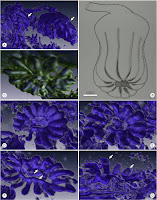

Micro-CT investigation of a seed fern (probable medullosan) fertile pinna from the early Permian Petrified Forest in Chemnitz, Germany
Authors:
1. Zhuo Feng (a, b, c)
2. Ronny Röβler (b)
3. Volker Annacker (b)
4. Ji-Yuan Yang (a)
Affiliations:
a. Yunnan Key Laboratory for Palaeobiology, Yunnan University, Kunming 650091, China
b. DAStietz, Museum für Naturkunde, Moritzstraße 20, D-09111 Chemnitz, Germany
c. State Key laboratory of Palaeobiology and Stratigraphy (Nanjing Insitute of Geology and Palaeontology, CAS), Nanjing 210008, China
Abstract:
A new bipinnate fertile pinna, Sterzelitheca chemnitzensis, bearing alternate synangia, is described from the Chemnitz Petrified Forest, Germany. The specimen occurs in the basal volcanic ash of the Zeisigwald Tuff Horizon, Leukersdorf Formation, Lower Permian. Because it is partially embedded in the tuffaceous matrix, X-Ray micro-Computer Tomography was employed to investigate the complete morphology without mechanical preparation of the hand specimen. The pinna is 66 mm long and branched once at least, the ultimate pinnae alternately positioned on the penultimate axis at angles of 45-55°. Stalked synangia are bell-like, borne alternately on both the terminal portion of the penultimate axis and the ultimate axes at angles of 25-60°. The smooth walled stalk is 3-7 mm long, 1-1.5 mm wide. Individual synangia are up to 6.5 mm in diameter and 10 mm long, and bear 12-14 elongated sporangia. Tubular sporangia are thin walled, circular in transverse section, arranged at the rim of the circular synangial pad around a central hollow. The unique preservational mould of the studied specimen is neither a permineralisation nor a compression-impression. It is three-dimensionally preserved, but lacks any organic remains. We provide the first detailed three-dimensional features of a probable medullosan male reproductive organ from the Chemnitz Fossil Lagerstätte. The relatively simple structure of the specimen offers a better understanding of the Palaeozoic seed ferns.

No comments:
Post a Comment